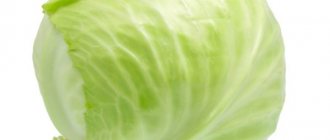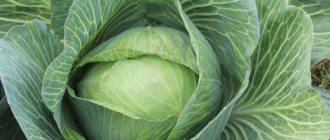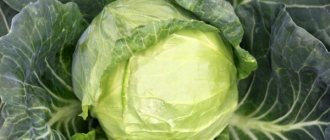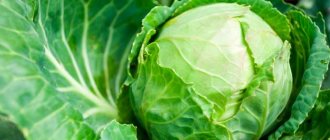Lennox F1 cabbage is a promising hybrid originally from the Netherlands. The vegetable has been included in the Russian register since 1993 and is intended for cultivation in various climatic regions.
| Landing location | Ripening time | View | Purpose | Origin | Maturation period | Weight |
| Open ground | Late ripening | White cabbage | Long-term storage, Cooking | Hybrid | 167-174 | 1,8-2,4 |
Lennox: description of a late variety of white cabbage, reviews, cultivation, planting and care
The main positive qualities of Lennox cabbage are good yield, resistance to most diseases, unpretentiousness to growing conditions, as well as the ability to grow and bear fruit when there is a lack of moisture in the soil.
These and other characteristics of the cabbage variety Lennox F1, the main advantages, and agricultural cultivation techniques will be discussed below.
.
The content of the article:
Lennox cabbage: description of the variety Lennox cabbage - yield Advantages and disadvantages Diseases and pests Lennox: growing cabbage, planting and care Reviews of the late Lennox cabbage variety Characteristics from the seed manufacturer
Lennox cabbage: characteristics and description of the variety
This variety was bred by Dutch breeders. And like all varieties of vegetables bred in the Netherlands, this cabbage has a lot of positive qualities. It’s worth starting with a description of the plant and its main characteristics.
Lennox cabbage is a late-ripening hybrid
. The heads of cabbage ripen 5-5.5 months after germination of the seed material. It is recommended to grow it both in private farmsteads and for industrial purposes. Growing methods - both seedlings and non-seedlings.
Photo of Lennox cabbage
Leaf rosettes of Lennox cabbage are comfortable, medium-sized, semi-raised. The foliage is large or medium in size, their shape is round, concave. The surface of the leaf blades is wrinkled, the color is emerald with a gray tint, with a waxy coating. This variety has very strong roots, so it tolerates periods of drought well.
The heads of cabbage are round, compacted, half covered with dense covering foliage. Color: green with a gray tint. The average weight of ripened fruits is 1.7-2.3 kg. The stalk is small in size. Lennox cabbage fruits are not prone to cracking
.
100 g of this cabbage contains the following ingredients
:
- sugar – up to 5%;
- proteins – not less than 0.55%;
- dry matter – about 8.4%;
- ascorbic acid – up to 41.8 mg.
Video description of Lennox cabbage
Collected heads of cabbage are of universal use; they can be salted and fermented, and used for preparing salads and hot dishes. The taste of cabbage is sweetish and persists for almost the entire storage time. The harvested Lennox crop can be stored for up to 7-7.5 months in appropriate conditions.
.
And even ripe heads of cabbage, if they are not collected on time, remain “on the bush” for a long time, without cracking or losing their taste. Many summer residents note that if the Lennox cabbage heads in the garden are affected by a slight cold snap (down to -2-3 degrees Celsius), they become sweeter and juicier.
Photo of Lennox Cabbage seeds
Care
Provide the plants with good care
Cabbage can be planted in two ways, seedlings and seeded. You need to start sowing cabbage seeds for seedlings in April to a depth of 1 cm. The suitable soil temperature for germination is 16-20°C. It is necessary to monitor and care for the plants, feed them with mineral-based fertilizers, water them in a timely manner, do not allow the seedlings to stretch upward, and be sure to ventilate them.
Before planting cabbage in open ground, it must be hardened off; for this, the plants are taken outside. When the seedlings are 35-40 days from germination, they are transplanted to a permanent place.
Treatment of animals with Biomycin powder and ointment: instructions for use and price
Lennox cabbage, according to the description, is unpretentious in planting, however, for a high-quality harvest, you should adhere to the following planting rules:
- Do not plant plants close to each other. Maintain a distance of up to 60 cm.
- Make sure that the root is completely covered with soil. Lower into the hole until the first leaf is reached.
- Maintain a planting depth of up to 7 cm.
It is advisable to plant in cloudy weather or after precipitation. The optimal time is evening.
Before planting cabbage seeds in open ground, prepare the soil. The soil must be well cleared of weeds, loosened, and the surface must be level. Several seeds are planted in the prepared holes, up to 6-7 pieces, to a depth of 2 cm. The hole is covered with prepared soil with peat and humus on top. The seeds germinate for the first time already on the 3-4th day, if the soil temperature is 18-20°C.
Advantages and disadvantages
The main advantages of the Lennox cabbage variety include:
- heads of cabbage are not prone to cracking;
- the harvest ripens together and at the same time;
- the heads of cabbage are approximately the same in size and density;
- the presentation and taste of Lennox cabbage heads are preserved for a long time on the vine and during storage;
- good taste of ripe fruits.
The only disadvantages that can be highlighted are the low resistance of the vegetable plant to clubroot and to cabbage fly damage.
Diseases and pests of cabbage
Lennox cabbage has average immunity and has good resistance to the following diseases:
- black leg;
- mucous bacteriosis;
- vascular bacteriosis.
But this hybrid has no immunity to a disease such as clubroot.
, so gardeners often have to fight this scourge. If plants are affected by clubroot already in the process of ripening heads of cabbage, then it is too difficult to fight the disease.
Therefore, all diseased plants are removed and immediately burned. And the remaining cabbage bushes should be hilled up more thoroughly and watered more abundantly. In the fall, you should dig up the soil, adding beet tops to it.
Video about cabbage diseases
The fungus that causes this disease can remain viable for 5-6 seasons. Therefore, in those beds where the disease was discovered, cruciferous vegetables cannot be grown during this period. To disinfect such an area, after harvesting, it is spilled with a solution of fluff lime (up to 600 g of powder is needed for each square)
.
And when planting this vegetable crop in other beds, pour 1.5 cups of lime milk into each planting hole.
In the area affected by clubroot, plants are planted that can destroy the pathogenic fungus. These can be vegetables from the nightshade, lily or goosefoot family
.
Lennox cabbage can also be affected by the cabbage fly.
. You can fight it by spraying with special insecticidal preparations or folk remedies.
Good variety!
Late white cabbage Valentina Broccoli cabbage Gnome
Traditional pest control
Most gardeners use the old advice of our ancestors, thanks to which you can easily get rid of pests on your site. For example, as noted earlier, Lennox is very often affected by the cabbage fly. If you plant garlic around the perimeter of the potato, it will begin to repel this parasite.
If there are problems with aphids in the area, then it is recommended to plant basil or dill.
But you shouldn’t limit yourself to these plants. Mint, sage, etc. will also work.
Lennox cabbage: agricultural technology for growing, planting and caring for the variety
For seedlings, Lennox cabbage seeds are sown in the first ten days of April.
. Growing seedlings should be picked at the stage of formation of cotyledon leaves.
Lennox seedlings are planted in a permanent place 1.5 months after the sprouts appear
when the plants have at least 5 permanent leaves.
This usually happens in the second ten days of May
. Planting pattern: 0.7*0.5 m.
Planting late cabbage for seedlings - video from an experienced gardener
Wood ash and mineral fertilizers are usually added to the planting holes before planting seedlings. You should also monitor the acidity of the soil - it should be neutral.
Further care for growing Lennox cabbage consists of observing the watering regime, loosening the rows while simultaneously removing weeds, as well as periodically applying fertilizing
. When applying fertilizers, it is recommended to alternate organic and mineral fertilizers.
Important!
You should not apply fresh manure or bird droppings under this cabbage variety.
Landing
Seeds for seedlings are sown from the last ten days of March. Use loose turf soil, to which add:
- compost;
- peat;
- humus.
Seed depth is 1 cm. Sowing step is 2-3 cm.
The seedlings are kept warm until germination; for this purpose, they are covered with film or glass. Then maintain the regime within 10-12 degrees to avoid overgrowth.
What are the nuances of caring for seedlings:
- moderate, uniform watering with settled liquid;
- feeding before and after picking with complexes and nitrogen mixtures;
- diving with 1-2 leaves;
- hardening procedures throughout the week.
Lennox cabbage: reviews from those who planted
On gardener forums, many summer residents leave their reviews about the late-ripening Lennox cabbage variety. Some of them are presented below.
Natalya, Moscow region: I tried Lennox cabbage salad at a party and immediately “fell in love” with this variety and decided to plant it in my garden. And I was right - this variety requires minimal care, the heads of cabbage grow large and dense, and do not crack under any weather conditions. And the shelf life of the crop is at least 7 months. In my garden the soil is quite fertile, so I didn’t add organic matter to the beds before planting cabbage, but I fed Lennox with ammonium nitrate twice during the season.
Olga, Izhevsk region: Several late-ripening varieties of cabbage grow in my garden beds, but the best of them, in my opinion, is Lennox. I grow these vegetable plants for further sale, so I consider this particular variety to be the best due to its high yield, uniform ripening of dense large heads of cabbage, as well as the excellent taste of ripe fruits. And the harvested crop can be stored until the beginning of the next season, practically without losing its pleasant taste. But during the season you need to regularly water the crops, loosen the soil, apply fertilizer and regularly spray the bushes against pests. I usually use a weak solution of potassium permanganate for this.
Lennox cabbage - photos and reviews
Tatyana, Izhevsk region: I have been growing this cabbage variety on my plot for the fifth season. I would like to note the high yield, good taste of ripe heads of cabbage and their density. Ripe heads of cabbage are stored in my cellar until the new harvest, without losing their taste.
Anna, Korkino village, Chelyabinsk region: For pickling, I grow the following varieties of cabbage on my plot - Krautman or Megaton. But for long-term storage I prefer to plant only Lennox.
Lennox cabbage is worth planting in your garden if vegetable growers want to get a harvest that can be stored in appropriate conditions until the next season. And if this vegetable crop is provided with good care, then fruiting will be friendly and abundant.
How and when to plant
As mentioned earlier, the planting process can be carried out using seedlings and non-seedlings.
Rassadny
So, if the seedling method was chosen, then the first step is to prepare the planting material. To do this, you should hold them for half an hour in hot water, and then dip them in cold water for a few minutes. The seeds should be refrigerated the day before planting. They should be sown in April.
So, prepare a wooden box, fill it with a nutritious earthen mixture. Now make furrows and send the seeds there. At the same time, make sure that a distance of 3 cm is maintained between them. The planting depth will be 1 cm.
After planting, cover the seedlings with glass. As soon as the first shoots appear after a week, the shelter can be removed. Now you need to regularly water the plants and apply fertilizer. For this you can use 5 g of urea, 20 g of superphosphate, 500 g of ash. Steam all this in 10 liters of water. Water the young plants with the resulting solution.
Before planting seedlings in open ground, they must be hardened off. To do this, take the container with the plants out into the fresh air. Keep them there every day for 2-3 hours. And if the nights become warm, then after 5 days you can leave the seedlings overnight.
The video shows a description of the cabbage variety:
As soon as they have 5 true leaves, the seedlings can be sent into open ground. Cloudy weather is suitable for this. After planting the seedlings, it is necessary to provide shade for several days.
It is also worth learning more about how broccoli is grown in open ground.
This information and photo will help you understand how Chinese cabbage is grown and how it is cared for.
But information and photos from the article will help you understand how to grow Brussels sprouts and how to care for them: //gidfermer.com/sadovodstvo/ovoshhevodstvo/bryusselskaya-kapusta-vyrashhivanie.html
Maybe
Lennox F1 cabbage: description and characteristics of the variety from the manufacturer
Late ripening (165-175 days) hybrid. The rosette of leaves is semi-raised. The leaf is gray-green with a strong waxy coating. The heads of cabbage are round, semi-closed, dense, with a large number of smooth, gray-green, thick covering leaves, weighing 1.6-2.4 kg. The taste is excellent.
The value of the hybrid: resistance to cracking, uniform yield formation, uniformity and density of heads of cabbage, retains commercial quality for a long time on the root and during storage. Recommended for fresh consumption and for culinary processing.
Manufacturers: Sedek, Prestige, Plasma Seeds and others.
Reviews from summer residents
Valentin Igorevich, Krasnoyarsk, 43 years old.
We have been planting Lennox f1 in our dacha for 4 years now. Therefore, I can leave a fairly detailed review. But I won’t, I’m too lazy to write. I’ll say right away that the cabbage is good, I didn’t notice any particular shortcomings in it. The fact that insects and various diseases affect every cabbage is the same, and this is far from a drawback. If you take good care, you won't have any problems with sores. The taste is excellent, ideal for fresh consumption, for fermentation and storage in the basement.
Ekaterina Viktorovna, Kyiv, 45 years old.










